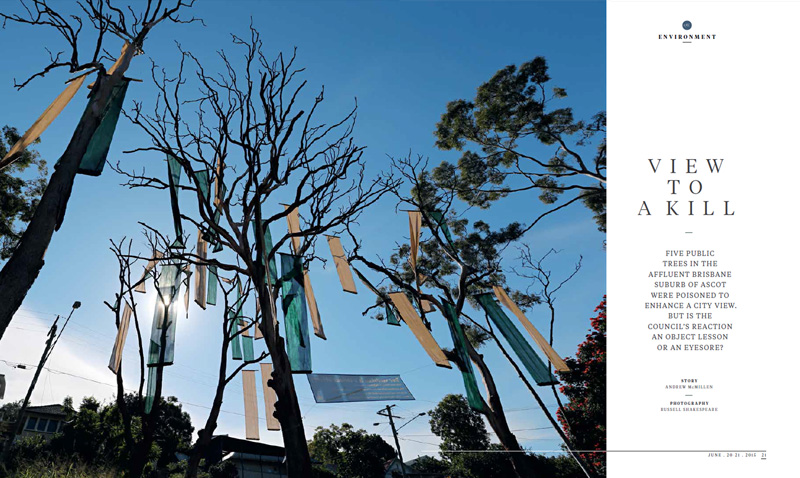Qweekend story: ‘View To A Kill: Brisbane tree vandalism’, June 2015
A story for the June 20-21 issue of Qweekend magazine. Excerpt below.
The poisoning of five trees in a Brisbane suburb is symptomatic of a wider problem of property outlooks trumping nature, but are councils’ reactions justified?
On a windy Friday, Andrew Stovell stares skyward, sizing up an eye-catching addition to a collection of tall trees in the inner-north Brisbane suburb of Ascot. What he sees is part art installation, part social experiment, yet its message is difficult to misinterpret. Stretched between two dead trunks is a large blue banner whose bold type reads: Tree vandalism is a serious offence.
In sum, five trees of the Eucalyptus and Corymbia genera that stood beside the busy thoroughfare of Crosby Road were poisoned last year: two tallowwoods planted on the traffic island that divides the road, and three bloodwoods that neighbour a small park area, including a public barbecue and picnic table. From a certain angle high above Crosby Rd, the gap in the foliage offers impressive views of the city. It all adds up to a suburban whodunnit in which the culprit or culprits have not been charged, for lack of evidence.
Stovell, 49, is a tall, affable arborist of 20 years’ experience who owns Redlands Tree Service. He is quietened by the sight of the dead trees, and by the strong measures Brisbane City Council has taken to address the matter. In addition to the bold blue banner and nearby corflute signage informing passers-by that the incident is being investigated, dozens of metre-wide shadecloth drapes have been affixed to the trees’ thick upper limbs.
“Two wrongs don’t make a right,” says Stovell, looking up. “I understand what they’re trying to do: ‘Okay, you didn’t have a view beforehand. You’re still not going to have a view, and you shouldn’t have poisoned the trees’.”
While poking around in the long grass at the base of the three trees by the footpath that runs parallel to Crosby Rd, Stovell uncovers ten fallen limbs, each around a metre in length, which are weighty enough to have potentially caused injury. Walking underneath the structure feels risky and somewhat foolish on this windy afternoon, as the banner and shadecloths contort in the breeze. When a mother pushing a pram on the footpath alongside her young son sees Stovell studying the scene, dressed in jeans, a blue polo shirt and work boots, she stops and calls down to him, worried: “Is it safe to walk past here now?”
Archival photographs taken by Google’s Street View car from 2007 onwards show the towering trees with healthy canopies providing shade to the footpath and nearby park area. The most recent Google image, from October 2013, is in stark contrast to what happened here in April 2014, when residents noticed that the five healthy, mature trees had mysteriously become ill overnight thanks to a generous application of agricultural poison.
Brisbane City Council officers undertook a letterbox drop and also doorknocked nearby residents in an effort to gather information about who might have been responsible for the poisoning but, without conclusive evidence, they were unable to enforce fines of up to $55,000 per vandalised tree.
David McLachlan is the councillor in Hamilton Ward, and it was on his watch that the shadecloth drapes and signage were installed in late January this year. While sitting at the park table in the shadow of the deadwood on a mild Wednesday morning, he says the council spent $14,000 on the installation, which was carried out by a contractor, Enspec. On advice from Enspec’s arborists, the trees and their attachments are to stay in place for two years, until the poison has leached from the soil.
The community response has been largely supportive of his actions. “We’ve had brickbats and bouquets; it’s probably running at 20 per cent to 80 per cent,” says McLachlan. “It makes me cross, angry and sad that people want to do this, but when it comes to improving property values, people lose sight of the broader community in which they live. The alternative was to leave the trees bare, and for people to continually ask, ‘What’s happened here? Why aren’t you doing something about it?’ Or to remove the trees, which would be the ultimate [act of] tapping the mat.”
To read the full story, visit The Courier-Mail. Photography by Russell Shakespeare.

